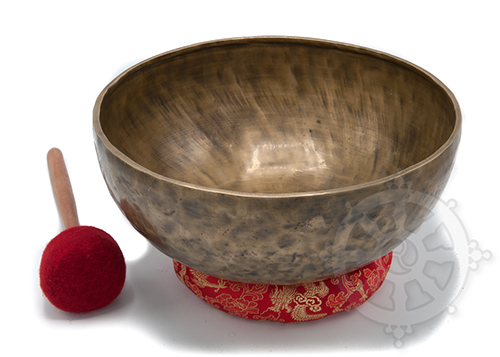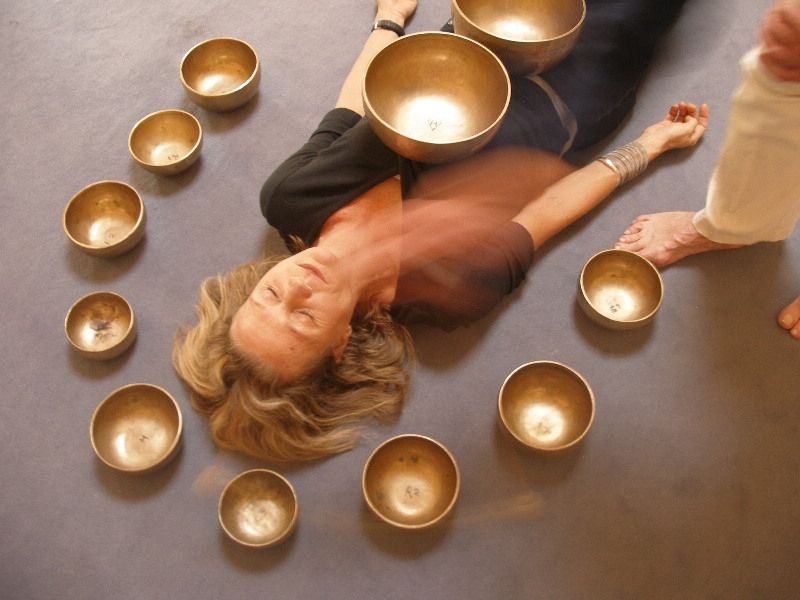How to choose your Tibetan singing bowl?

Singing bowls or Tibetan bowls are a special form of upside down bell without a clapper that is resounded with a mallet. Initially used as a traditional instrument by the Mahayana and Tantric Buddhist schools, they are found mainly in the Himalayan regions (Tibet, Nepal, Bhutan, Ladakh...) and in northern India, but their use is widespread in many regions of Buddhist influence.
What are the important criteria to consider before buying a Tibetan bowl?
How to choose a Tibetan bowl Nowadays, many people are learning to use Tibetan singing bowls and wish to use them as a therapeutic or meditation instrument.
1. The quality
Examine the look and sound of a good singing bowl. If you are not an expert, seek advice from someone who knows. Many people sell bowls and most are new and machine-made to look old. Specialists who can tell the difference are very rare and it is very often impossible to really date a bowl. How can you certify that a bowl is 200 years old without carbon dating? It is often better to buy a new bowl of very good quality than to venture into bowls with attractive but impossible to verify denominations (Tibetan Full Moon singing bowls, antique singing bowls, etc.). Be sure of its origin and check if there is a return guarantee with the bowl as well as the duration of this guarantee.
2. The use
What will you use your singing bowl for? Meditation, therapy, concerts, company workshops, etc. The answers to this question will have an impact on your choices. It is good to know what the Tibetan bowl will be used for before you buy it. There are also many types of mallets made of wood, felt, etc. that will produce a different sound when using your Tibetan singing bowl.
3. Notes and vibrations
A Tibetan singing bowl must vibrate and hold the note long enough when struck, producing several variations of tones and harmonics. If the vibration and volume of a bowl quickly fades away, it is of poor quality even if it has a singular tone. Always hit a bowl with the padded part of a stick rather than the wood to produce a soft, full sound. When "singing" the bowl (by rubbing the rim of the singing bowl with the wooden or leather part of a stick), there are several things to consider. Some bowls sing right away, others need to be played for a while. This is not a sign of good or bad quality, it is a reflection of the personality, the typicality of the bowl. When you hear the sound of a bowl, listen to your body, feel its vibrations and sensations. If you feel a tingling sensation, this is a positive sign. Remember that the bowls have been designed to make you feel their benefits through their use. Feeling is therefore essential.
4. Aesthetics
The appearance of a Tibetan bowl is also an important part of the selection process. Its size, shape and visual appearance should speak to you. It is important to spend some time looking closely at the different aspects of the bowl. Make sure that it is also of a size and weight that will allow you to use it for a long time. It is not easy to hold a 3 kilogram singing bowl at arm's length during an entire therapy session. Some bowls have deep hammer marks, are polished, oxidized or not. Sometimes some mantras and symbols are finely engraved and chiseled on the singing bowl. All these elements must be taken into consideration when you are looking for your Tibetan singing bowl.
5. Tibetan bowls and chakras
In the West, most practitioners are concerned about the note of the singing bowl and its correspondence with a certain area of the body. Although this works well, it is worth noting that Tibetan singing bowls produce overtones, and are created to reflect the whole body. Choosing a bowl for its note is useful and having several singing bowls is wonderful, but even if you only have one, it will have an impact on the whole body, not just one chakra.
What is sound and vibration healing from the Tibetan bowl?
This section is taken from SHRESTHA's excellent book, Suren, "How to Heal With Singing Bowls: Traditional Tibetan Healing Methods". Sentient Publications. Available at sentientpublications.com.
Each of us has ONE vibration that is the signature of our good health and well-being. You may perceive it as a natural result of the processes that direct our physical bodies as well as our mental, emotional and subtle bodies.
The vibratory harmony of the Tibetan bowl
Similar to a musical instrument that can become out of tune after use, our bodies can also fall out of this "vibrational harmony" and potentially develop a disease. Stress and negativity create blockages that can disrupt a healthy flow of energy in the body. This will first appear in the energy field around our body as small energy disturbances, which can later turn into a disease in our physical body. Sound and vibration can be used to "retune" us to health and one of the most powerful modalities for this is the use of Tibetan singing bowls.
 When a person experiences deep relaxation brought about by the soothing, resonant sound of the bowls, the body is affected at the cellular level, opening a flow of energy that takes us back to the beneficial vibrational alignment. Sound can also help us to shift our energy frequency between low and high frequencies, eliminating lower frequencies of emotions such as fear, anger and resentment.
When a person experiences deep relaxation brought about by the soothing, resonant sound of the bowls, the body is affected at the cellular level, opening a flow of energy that takes us back to the beneficial vibrational alignment. Sound can also help us to shift our energy frequency between low and high frequencies, eliminating lower frequencies of emotions such as fear, anger and resentment.
The effects of Tibetan bowls
The sound of Tibetan bowls is calming, and they are frequently used as an aid to meditation, as the sound induces a sense of peace.
Quantum physics has proven that everything has a vibration, be it a table, a chair, a person, a planet or a cosmos. And wherever there is a sound, there is a vibration. When we use sound coupled with intention, which is the most important aspect of healing, we can direct the sound vibration to raise the vibrational frequency of the body. Negative energy can make us physically ill or mentally depressed. Each bowl emits a soothing vibration that radiates the negative energy that limits your ability to achieve full physical, spiritual and mental health. Once your negative energy is radiated by the vibration of the bowls, you are ready to allow yourself to live in harmony with the immense energy of our seven chakras. Healing through sound and vibration reduces stress, improves concentration, reduces blood pressure, stimulates vital energy in the body, improves immunity, harmonizes the chakras with the energy field, strengthens intuition and perception, synchronizes the brain hemispheres, suppresses and emotional negativity, and enhances creativity. Most importantly, stress is at the root of many 21st century illnesses and it is through relaxation of the body that balance, health and happiness can be restored.
This salutary effect is produced by the invisible power of the vibrating bowls, combined with prayer.
The history and manufacture of Tibetan bowls
The making of traditional singing bowls dates back to about 2400 years in Buddha's time and has been perpetuated from generation to generation in India, Nepal and Tibet through verbal teaching within a highly structured family clan or caste system. Today, craftsmen from Nepal in the Kathmandu Valley are working to revive the ancient techniques of bowl making. The Shakyamuni clan still makes healing bowls today, chanting mantras while they make the bowls. This is the same method that dates back to Buddha's time. Oral history tells us that the bowls came from India to Tibet at the same time that Buddhism was introduced to Tibet by the great Buddhist master Padmasambhava. Therefore, the history of Tibetan singing bowls dates back to the 8th century AD. AD. These bowls are traditionally made of a special alloy of seven metals of gold, silver, iron, mercury, tin, copper and lead. Each of the sacred metals is aligned with the seven celestial bodies in our solar system and the seven chakras of our body. In addition, each bowl is adjusted to the specific note that affects an individual chakra. Each bowl begins as a molten mixture of the seven special sacred metals. The bowls are generally three inches to fourteen inches in diameter, but can also be larger or smaller.
Types of Tibetan bowls
Introduction
Some researchers have identified nearly 50 types of ancient Himalayan singing bowls, but there are only seven or eight basic types, each with its own shape and characteristic sound, and perhaps seven other less familiar types with subtle variations in shape.
The Tibetan bowls of Thadobati
The Tibetan bowls of Thadobati are among the oldest forms of singing bowls, some examples of which date back to at least the 15th century. The old Tibetan Thadobati singing bowls are quite numerous on the market and remain relatively inexpensive, but their quality varies considerably, as very good Tibetan Thadobati singing bowls are very rare.
Thadobati bowls are characterized by high, almost straight walls and a wide, flat bottom, sometimes with a diameter barely smaller than the rim. The walls can be thick or thin. The rim is usually smooth on small and medium weight bowls, and rarely thicker than the wall itself. Heavy bowls often have thicker and wider lips that may be grooved or decorated with a ribbon of mala beads.
These Tibetan bowls are usually hand-held and easy and rewarding to play with a suede or wooden mallet, although the small Thadobati bowls from Thadobati respond better to the wooden mallet. The edge note is played more often than the fundamental note struck, and the edge note may change depending on the type of mallet used. Thadobati's large, thick and heavy singing bowls, in very good condition, with a superb sound and which hold the note for a long time, are highly prized by collectors.
Tibetan Jambati bowls
The Tibetan Jambati bowls are the largest and heaviest of the Tibetan singing bowls family. These beautiful Tibetan bowls are characterized by their rather high and gracefully curved walls, a small flat bottom and, in general, a generous inward-facing lip, which can be either smooth or grooved. The decoration is minimal and is usually limited to a few simple incised lines forming a band or collar near the outer rim, and several concentric incised circles radiating from the centre of the bowl.
These hand-hammered singing bowls very often bear the mark of hammers from the forging process. High quality bowls have smaller hammer marks, and sometimes an incised (unpunched) inscription in the form of a mantra, name or dedication.
Since it takes precious metals and 3 or 4 highly skilled craftsmen working together to forge a single Jambati singing bowl, the cost of these singing bowls is quite expensive.
It is believed that most of the old Jambati singing bowls today date from the 17th to 19th centuries. Many are in excellent condition for their age... proof that they have been well maintained or used for ceremonial, ritual or musical purposes.
Tibetan Jambati bowls are capable of producing wonderfully deep and sonorous sounds with a very long hand of the note. The fundamental notes generally range from the 2nd to the 4th octave when struck with a padded mallet. The edge note is usually the same if played with a suede mallet, but it can be higher if a wooden mallet is used. Many bowls have complex multiple overtones.
Some people choose to strike only their Tibetan Jambati singing bowl, while others prefer to play it.
Naga singing bowls
Naga singing bowls are forged from two pieces. The bowl itself and a circular metal band that makes up the base to which the bowl is permanently attached. The bowl has a rounded bottom and would not stand upright without the support of its pedestal. Naga singing bowls are quite bulbous, with the centre having a larger circumference than the rim. The lip is normally smooth but can be grooved on thicker and heavier bowls.
Little is known about the age and origin of these unusual singing bowls, except that they have a unique shape and are now relatively rare.
Naga singing bowls are played around the rim rather than struck. They are extremely responsive and easy to play. Their ample shape produces a surprisingly loud and brilliant sound when played around the rim with a mallet. Their notes are very often concert level, and tend to be in the middle to high octaves. Ancient Naga singing bowls are very popular with sound therapists and healers because they can be grasped by the pedestal and held at any angle or distance above, around or below a client during therapy. Feng Shui practitioners also use them for space cleansing.
Why is it called 7 metal Tibetan singing bowl?
The quality of a 7 metal Tibetan singing bowl also depends on its composition, i.e. the alloy that makes it. Traditionally, Tibetan 7-metal singing bowls were made from a mixture of five or seven metals: gold, silver, mercury, copper, iron, tin and lead.
It is also common to relate the metals to certain stars and chakras.
- Gold: Sun
- Money: Moon
- Iron: Mars
- Mercury: Mercury
- Tin: Jupiter
- Copper: Venus
- Lead: Saturn
The composition of the alloy has varied over time and the sound will be affected. That is why it is very important to feel the sound of its Tibetan 7-metal bowl. Most bowls today are made from industrial manufacturing processes and are made from a less elaborate and qualitative alloy.
Scientific study on the effects of Tibetan bowls
A study published in 2016 in the Journal of Evidence-Based Complementary & Alternative Medicine, Effects of Singing Bowl Sound Meditation on Mood, Tension, and Well-being: An Observational Study, by Tamara L. Goldsby, PhD, Michael E. Goldsby, PhD, Mary McWalters, BA, and Paul J. Mills, PhD, (2017 Jul; 22(3): 401-406. Published online September 30, 2016 ) examined the effect of Tibetan meditation using the sound of Tibetan singing bowls on emotions, nervous tension, and overall well-being.
We advise you to read the original article but we try here to write a summary of this article.
There is generally very little scientific research on the subject of alternative medicine healing. That is why a team of researchers from the University of California has investigated the particular subject of sound therapy and has published the findings of this study.
They studied 62 male and female participants with an average age of 49.7 years. Before and after the sound healing session, all participants completed standardized questionnaires to assess tension, anger, confusion, depression, anxiety and spiritual well-being. Participants also completed questionnaires that included questions about any previous experiences with meditation or singing bowls, use of consciousness-altering substances, medications, etc., and whether and to what extent they were experiencing physical pain.
Participants lay on yoga mats, with their heads close to the instruments, and listened to the sound meditation for about 60 minutes. The musical instruments used were Tibetan bowls, crystal singing bowls, gongs, Tingshas (small cymbals), bells, didgeridoos and other small bells. The Tibetan bowls were mainly played 95% of the time during sound meditation, while the other instruments were played only 5% of the time. Depending on the size of the room and the number of participants, between 30 and 80 singing bowls were played, with at least two Tibetan bowls near the head of each participant. A singing bowl practitioner led the sound meditation using cloth-covered mallets to extract various sounds by striking the bowls sideways or rubbing the edges of the bowl.
The researchers found significant differences before and after practice in the tension, anger, confusion, depression, anxiety and well-being of participants. Tension was reduced quite impressively in all participants, suggesting that sound meditation has the ability to increase feelings of relaxation and decrease feelings of stress.
Depressed mood and anxiety also decreased significantly after meditation, and feelings of well-being increased after meditation.
The study also found that participants who had no previous experience with singing bowls showed greater effects than those who had some previous familiarity. For example, participants aged 40-59 who were not interested in this type of meditation seemed to benefit most from sound meditation. This was demonstrated in particular by a significant reduction in pain and physical tension.
These findings are interesting for many reasons.
The results are promising for a form of stress reduction that is inexpensive and easier to learn than meditation. The Tibetan bowls are simple to use, and users can expect to experience deep relaxation at the end of the therapy.
Health professionals, such as nurses and health counsellors, could easily offer sound meditation to patients for a relatively small cost or training investment. Singing bowl meditation could be taught to these professionals and would be simple to provide in many settings to reduce stress and invoke the relaxation response.
The study also shows that it is possible to reduce stress-related body diseases through sound meditation. This has long-term benefits in terms of health care spending.
The Tibetan system and the fifth system
The Tibetan order of the planets is the speed at which they appear to move from the point of view of an observer on earth, with the moon as the fastest star and Saturn as the slowest, with the sun in the middle.
This is an ancient system used by astrologers and alchemists, and of course it does not include the planets that had not yet been discovered: Uranus, Neptune and Pluto.
The sound achieved in a 5 note sequence is relaxing, soothing and centered to listen to.
Ancient Tibetan Singing Bowl Therapy teachers set up their singing bowls in a pattern where they strike the bowls at fifth intervals because they feel the sound is beautiful to hear, and the vibrations of the fifth are especially good for balancing the heart chakra.
To arrange a set of singing bowls in fifths, we simply place them starting with the note F at the root chakra and increasing by one note for each chakra.
Correspondences between the sounds produced by the Tibetan singing bowls and the Chakras
| Chakra | Symbole | Zone | Couleur | Note (tib.) | Note (véd.) | Pierre | Mantra | Fragrance |
|---|---|---|---|---|---|---|---|---|
| 1- Muladhara |  |
Coccys | Rouge | Fa - F | Do - C | Agate - Corail | LAM | Vétivier - Girofle - Basilic |
| 2- Svadhisthana |  |
Pubis | Orange | Do - C | Ré - D | Cornaline | VAM | Bergamote - Santal - Ylang ylang |
| 3- Manipura |  |
Plexus solaire | Jaune | Sol - G | Mi - E | Ambre - Citrine - Oeil de tigre | RAM | Géranium - Gimgembre - Citron |
| 4- Anahata |  |
Coeur | Vert | Ré - D | Fa - F | Jade - Malachite - Quartz rose | YAM | Verveine - Rose |
| 5- Visuddha |  |
Gorge | Bleu ciel | La - A | Sol - G | Turquoise | HAM | Laurier - Eucalyptus - Menthe |
| 6- Ajna |  |
3ème oeil | Bleu foncé - Indigo | Mi - E | La - A | Lapis-lazuli | OM | Sauge - Romarin |
| 7- Sahasrana |  |
Sommet du crâne | Violet | Si - B | Si - B | Améthiste - Cristal de roche | AUM | Sauge - Romarin |
Techniques for using your Tibetan bowls
It is obvious that there are many ways to use Tibetan singing bowls. Here are a few examples among many others.
Hitting your Tibetan bowl
You hit the singing bowl with a different type of mallet and wait for the sound to dissipate. This technique requires a minimum of practice and is easier to master.
Rubbing the edges of your Tibetan bowl
One can also play his Tibetan singing bowl by rubbing the edge with the wood or leather of his mallet. Care must be taken to ensure that the mallet remains permanently in contact with the metal of the bowl, that the pressure is constant and the speed of movement regular. After a few moments, a vibration arises from the bowl and starts to intensify as you rub the edge of the singing bowl.
Using your mouth to amplify the sound of your Tibetan bowl
The previous technique is used to obtain a stable vibration and then at this point the mouth is opened and the edge of the bowl is brought a few centimetres closer. And varying the opening of the mouth, the sound of the bowl will use the oral cavity as a resonance chamber and produce intense vibratory sensations.
Playing his Tibetan bowl filled with water
Fill the bottom of the bowl with a few centimetres of water and make the bowl sing as it rubs. As the vibration rises from your Tibetan singing bowl, in addition to the sound, different vibratory phenomena are observed impacting the water contained in the singing bowl.
Taking care of your Tibetan bowls
Never use brass or copper polish. Use half a lemon and warm water to wash the bowl.
Play the bowl daily to honour your relationship with it. If you are going to put the bowl on your body, put hot water in it. This will have a balancing effect on the elements (earth, air, fire, water, metal).
Travelling with Tibetan bowls
When traveling with singing bowls, wrap them in newspaper, cloth or bubble wrap so that they do not rattle. You can nest smaller bowls into larger ones as long as you protect them from each other by wrapping them. You can carry them in a suitcase or heavy canvas bag.
